Aurora Pours: Thoughts about Iron
Suzanne Szucs writes about her experience of the North Shore Iron Pour this August. Since this writing, Hurricane Katrina has struck artist Coral Lamberts home and studio in New Orleans. Send inquiries about aid for her to editor@mnartists.org.
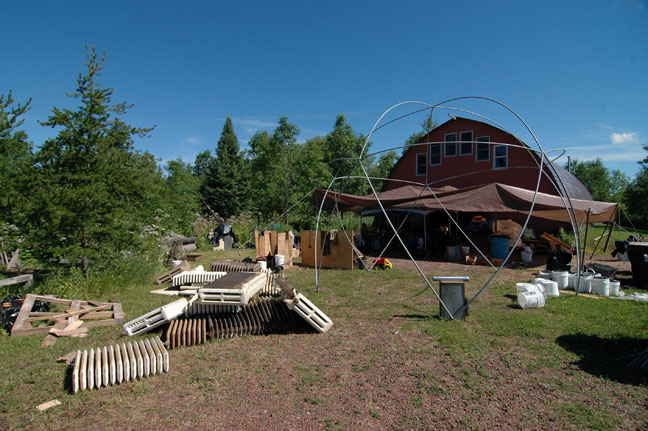
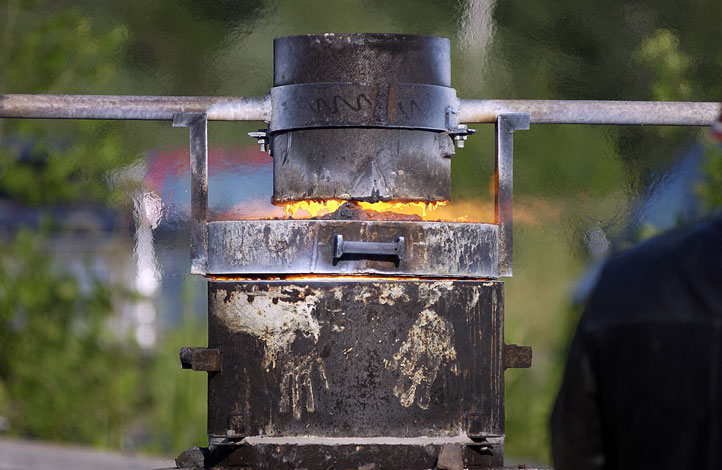
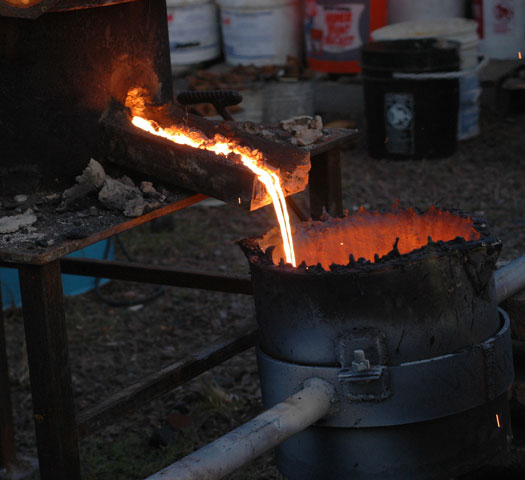
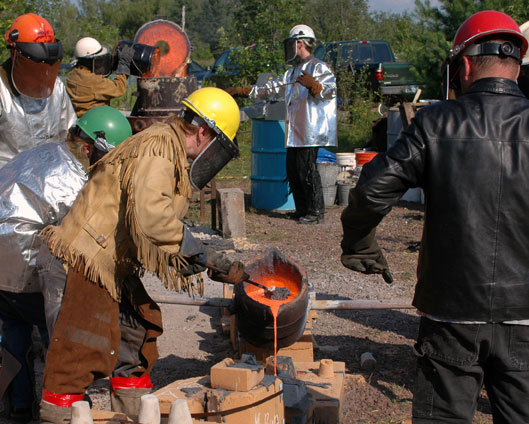
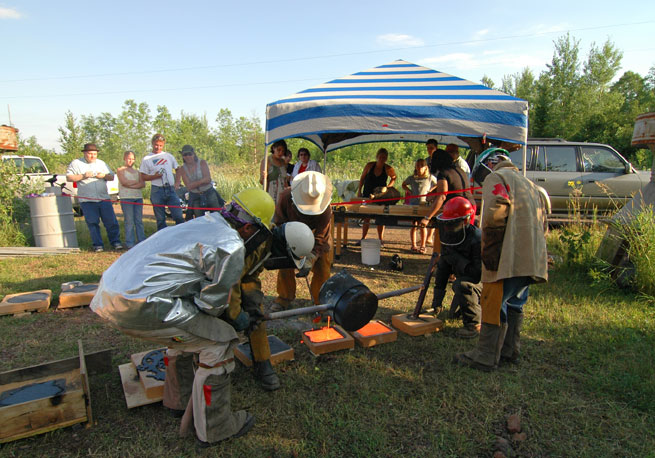
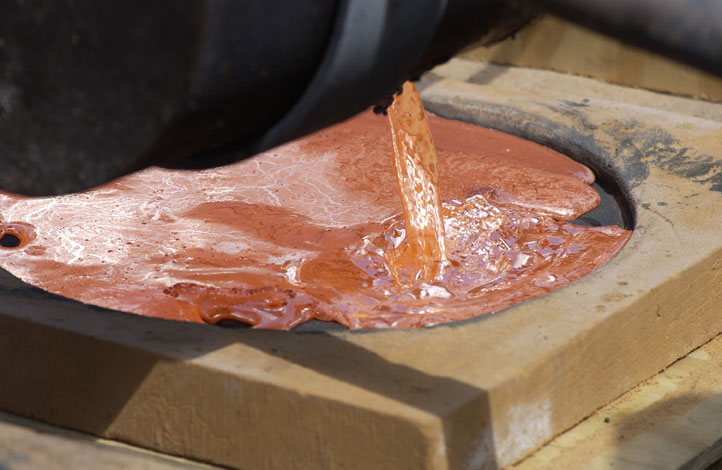
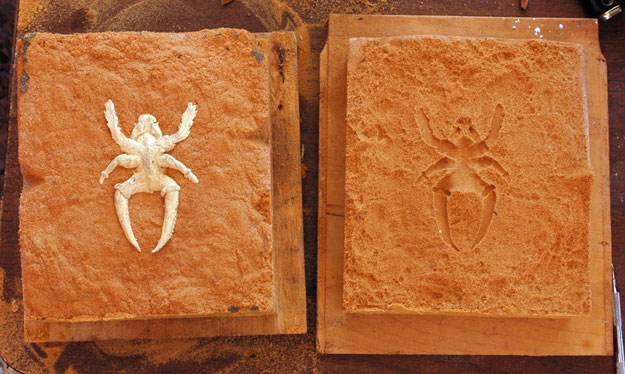
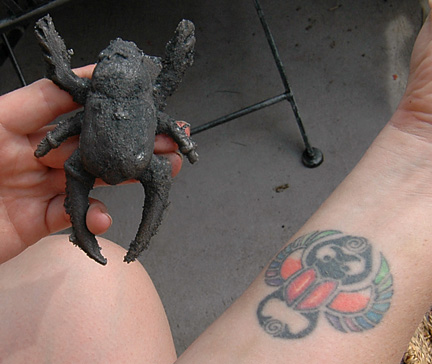
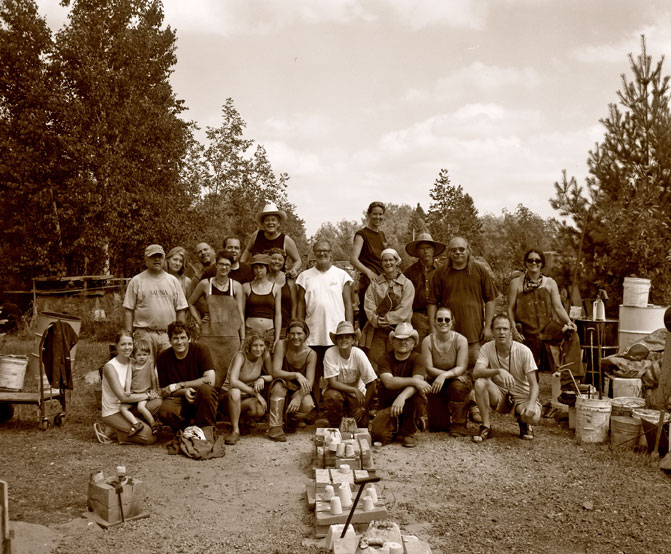
“Come ‘round, we need to have a meeting,” shouted Coral, who was, if not our absolute leader, the one for whom we all had absolute respect. We gathered under the tent canopy that jutted out from the studio/barn, escaping the heat for a moment and chugging down lukewarm water.
“We have a choice. We can either pour tomorrow OR we can take a break, go to the beach, chill out, and pour this evening. Who wants to pour?”
Without hesitation, without looking around at one another, three-quarters of the 20 participants raised their hands. The other five were probably just too slow to make the quick draw. Beach, pour, margaritas… that’s how it would be. After a full day’s work already– two thousand pounds of iron sledgehammered out of recycled radiators; molds packed and finished; the furnace placed upon its throne and burned out – after all that labor in the heat of the thirtieth of July, we still wanted more, we still wanted a solid evening of hot grueling work to round out our day.
Iron is seductive. It takes 2750 degrees to melt it. A participant in a week-long iron pour with a homemade furnace that can melt 100 pounds of iron at a time agrees to a sentence of hard labor. It’s a collective experience, with every artist responsible for busting up iron, mixing batch after batch of sand-resin compound, building and packing molds, not to mention making the sculpture and, oh yeah, taking turns at preparing the communal meals. The pour itself is an all-day affair. Always contingent on the weather as rainy conditions can cause molds to explode, pours rarely start on time and often last well into the evening with participants working in shifts. They charge the furnace, rotating on pouring out the crucible of liquid metal and skimming the slag off the top, hour after hour after hour, until the molds are filled, the metal is finished, or the furnace just gives up.
As the brainchild of Tweed Museum of Art curator Peter Spooner, and Common Language president Jeffrey Kalstrom, a Northshore cast iron pour was first held at the University of Minnesota Duluth in 2000. Now held in Poplar, Wisconsin, for the Duluth arts collective the cast iron pour has become an annual event. Last year the group brought in British cast iron sculptor Coral Lambert to build a furnace that would stay in the Northland – a daunting task. Working for a week with Texas native Alair Wells and Common Language member Felicia Glidden, the three women pounded out “Aurora,” as the furnace would be named. She is a beautiful creature, in three parts herself, but then standing about 7 feet once on her pedestal. Later in the week, the rest of us lined her insides with refractory material to keep the steel heat-safe and lit her on fire to cure. I could wax poetic, but suffice it to say, now we have our own furnace and Coral doesn’t have to lug hers up from Louisiana every time we want to do a pour.
When most people think about cast iron, they think about a foundry. To participate in an iron pour is something much different. It is a collaborative effort, kinda like a theatrical production, where you workshop and share ideas all week, creating and preparing for the grand performance at the climax. Photography is my primary medium so working in sculpture is playful and risk-free for me. It’s addictive. I’ve met people on pours who always make sure they are there, no matter what else is going on in their lives. At Coral’s pour the following week at Franconia Sculpture Park (look for an upcoming feature on that project), I met Sarah, who seems to chase pours all over the country. Megan, who participated in both the Poplar and Franconia pours, is moving to the Bay area soon. She talked to me excitedly about getting a contact from Coral for an iron studio in Berkeley.
I asked Jim Brenner, metals sculptor from Chicago who also helps run the furnace, what iron heads are like – what are their various styles, their schools of thought? He told me that the new school considers the pouring itself performance art. For artists like Matt Toole, the iron sculpture left behind is residue. The artmaking process comes in stages, with melting and pouring as important as the relic. Performing with iron is like extreme sports – it is easy for things to go wrong, defeat expectations, or for somebody to get hurt. It is a magnification of the whole iron pour process. You might spend the week making a sculpture, creating a mold, preparing to pour, but there is no guarantee it will work out, or in what shape. In this way, pouring iron is an act of faith. For many it is not just art, but also a spiritual experience.
And then there is the post-processing. Finishing a cast iron piece includes cutting off the sprue and vents, grinding down all the bits of metal that formed between the seams, more grinding to create the look you want and adding a patina. For my part, I still haven’t finished my pieces from last year – two boxing gloves that weigh in at about 40 pounds each. So this year I decided to go small and make work that didn’t need a lot of finishing –-that means the scratch mold technique: carving a design into a block of resin sand and pouring it open-faced, as opposed to creating a mold from an object into which the iron will be poured. It’s a relief—in more ways than one. I carved a 12-inch monkey (like the plastic ones in the kids’ game) and everyone had an opinion. “Oh, you should make a back for it… you should make at least 3 monkeys… you should cut sprues… use a cup… use two cups!!!” Okay, all right already!
Because the participants are so into the process, they all want everyone’s work to be the best it can be. It’s a matter of pride that all the pieces are successful, so a lot goes on during the week to ensure a good pour. A lot of questions, a lot of advice, with experienced sculptors sacrificing their own time to teach proper technique. When the molds are cool they are opened with glee like Christmas presents, participants like school kids looking over shoulders, cheering each other on, empathizing with failed molds (although I have never seen anyone display real disappointment). When Sean Smuda brought his small scarab piece to breakfast on Sunday, we passed it around, “ooing” and “ahing” as though we were examining pictures of his new baby.
We poured on Saturday evening and it was fabulous and very hard. The public came out to watch and busied themselves under a canopy carving scratch molds (for which they gave a donation). On the first tap iron ran out of Aurora like orange-hot blood to the cheers of everyone present. Then after 1000 pounds, Aurora gave up, leading some of us to wonder if she is a thousand pound furnace, and other, more experienced folks to speculate that the refractory is too thick, or the iron pieces too large. We had another decision to make and with the molds only half poured, decided, or she decided for us, to shut her down and try again on Sunday. As is Coral’s tradition, we gave a chant for the day’s work, and went on with the party that should have been the “pour is finished” celebration.
In the morning, the weather was once again beautiful and we were able to get the furnace going in no time thanks to some heartier members of the crew. It seemed like a breeze to pour without the general exhaustion of Saturday and after a good night’s sleep. Yet again, after only 6 taps, we were forced to stop. We had run out of coke to fuel Aurora. Roger and Steve mentioned, though, that we had a couple of bags of charcoal left from Friday night’s barbeque. “Throw ‘em in,” barked Coral. And we did, for another 100 pounds of iron and a few more molds filled. And none of us wanted to stop.
“Pour next week in Franconia… bring your molds down,” grinned Coral, knowing that the Minnesotans, at least, wouldn’t be able to resist.